
- Date
- 29th September 2021
- Categories
By Mourine Chepkemoi (African Centre for Technology Studies (ACTS)) and Jon Leary (Loughborough University & Gamos).
We know that Electric Pressure Cookers (EPCs) can revolutionise someone’s kitchen, however marketing an EPC is a difficult job if you don’t have the facts at hand! In this article we reflect on the main questions asked by visitors at the MECS booth where we were showcasing EPCs at GOGLA’s Global Off-grid Solar Forum and Exhibition event in Nairobi on 18th-20th Feb 2020, shortly before the world went into lockdown.
The 5 most asked questions were:
- What can I cook with an EPC?
- Cooking with electricity is very expensive, what makes an EPC affordable?
- How about the taste of food when using EPC – I’m worried that it will taste different, somehow flat?
- Explosions! I just get scared of pressure cooking and worse off when connected to the electricity
- Where can I get these EPCs?
- What can I cook with an EPC?
It is possible to cook over 90% of Kenyan meals in an EPC. Of course, ‘heavy foods’ like beans are what it does best. Our kitchen laboratory experiments for the Kenya eCookBook showed that pressurising the cooking pot reduces cooking times by half and combined with the insulation and automatic control, energy consumption is reduced by up to 90%. However, it can also cook staples with shorter cooking times like rice and potatoes. At the end of our cooking diary study, where 20 participants trialled EPCs and other electric cooking appliances at home, we asked our participants how easy it is to cook each dish. ‘Heavy foods’ such as beans or matumbo (tripe) that usually require boiling for an hour or more to soften are unsurprisingly rated as much easier to cook on the EPC than the hotplate. In contrast, foods such as chapati or mandazi (doughnuts) that require manual heat control &/or a shallow pan are rated much easier to cook on the hotplate.
How easy is it to cook each food on the eCookers?
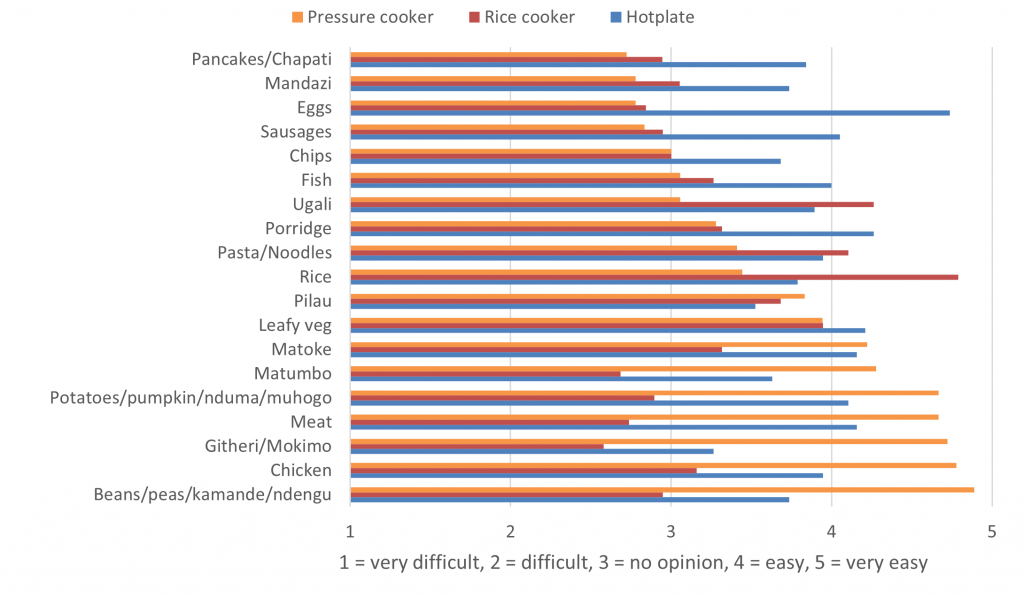
Ranked by ease of cooking on an EPC. Data from Kenya Cooking Diaries 2018 Final Report.
Just because an EPC can pressurise, doesn’t mean it has to. In fact, many people call an EPC a multicooker, as it can perform multiple cooking functions. All EPCs can pressure cook and boil, almost all can shallow fry and some models can even bake, slow cook and deep fry too. Cooking ugali (maize flour porridge) is very easy, as long as you’re able to hold the pot still whilst stirring with a cloth or heat-proof glove (see Zambian Kitchen’s video tutorial for cooking nshima/ugali in an EPC). Shallow frying sukuma wiki (kales), or eggs also works well, however getting an omelette out of the pot after frying can be challenging.
The one type of popular Kenyan dish that all EPCs really struggle with is flatbreads, such as chapati. Usually, a flat pan is used, as chapatis need to be turned regularly – the EPC’s high sided pot makes it hard to access the chapati. It also needs a medium heat, evenly distributed across the pan to make the chapati cook well. The EPC pan is evenly heated, but on most models, you cannot control the heat level manually, so it burns the chapati.
The typology of foods in the table below lists the typical foods on the urban Kenyan menu, as recorded in the cooking diary study mentioned above and analysed in Experiences of EPCs in East Africa.
| Food category | Description | Frequency on urban Kenyan menu | Typical dishes | Compatibility with EPCs | Energy savings with EPCs |
| ‘Heavy foods’ | Usually require boiling the main ingredient (e.g. beans) for over an hour on a conventional stove and may also contain a frying stage with extra ingredients to add flavour (e.g. a tomato and onion sauce). | 32% | Beans, matumbo (tripe), meat stews | Users instinctively use EPCs | High (50-90%) |
| Staples | Normally boiled for approximately half an hour. Some require stirring (e.g. ugali, porridge), but others are simply left to boil (e.g. rice). | 39% | Ugali (maize meal), rice | Users use EPCs if encouraged | Moderate (20-50%) |
| Quick fry | Usually fried for 5-15 minutes, a shallow pan and high heat is often preferred, but not essential. Access to the pan is usually required to stir the food and prevent burning. | 20% | Sukuma wiki (kales), eggs | Users use EPCs if encouraged | Low (5-20%) |
| Deep fry | Food is completely submerged in oil at 175-190°C. | 2% | Mandazi (donut), fried chicken, chips | Users cannot currently use EPCs | Low (5-20%) |
| Flat breads | Medium heat, evenly distributed across a shallow pan is required to cook the whole of the flat bread at the same rate. Access to the pan is required to turn the bread frequently. | 4% | Chapati (flat bread) | Users cannot currently use EPCs | Low (5-20%) |
| Other | 3% | Unknown |
If you have an EPC and are looking for inspiration, check out Shamba Shape Up Series 10 or Series 11 or look up Kenyan social media icons Jikoni Magic and Nimoh’s Kitchen, who are creating a growing set of recipes for Kenyan foods that are even more delicious in an EPC.
2. Cooking with electricity is very expensive, what makes an EPC affordable?
In the cooking diary study carried out in Nairobi, the average consumption for households cooking all their food with electricity using three appliances (a hotplate, a rice cooker and an EPC) was 1.92kWh per day for an average household of 4.2 people. Kenya Power currently charge domestic customers on the regular tariff of 23 KSh/kWh, meaning that cooking all your food with electricity would cost 44 KSh per day, or 1,320 KSh per month.
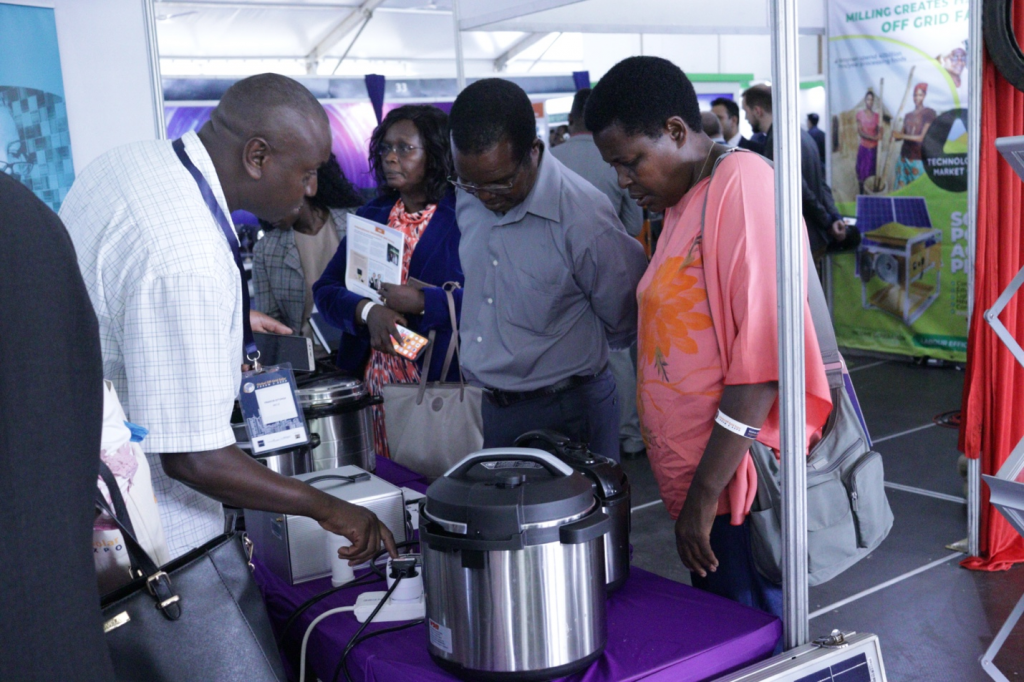
The EPC is much more energy-efficient than the hotplate and even the rice cooker. The cooking diary study also showed that without substantial training, participants chose to cook half their food with the efficient appliances. It also showed that the efficient appliances used an average of half the energy of the hotplate over the full range of dishes that people chose to cook with them. This means that if you were to use an EPC alongside another fuel, for example LPG, you would likely use just 0.64 kWh per day (or 19 kWh per month), which would cost just 15 KSh per day (or 450 KSh per month).
These cost comparisons are explored in greater depth in the first case study in the Cooking with Electricity: A Cost Perspective report, which explores grid-connected eCooking in Nairobi and the Kenya eCookBook.
However, what the EPC really does best is boil heavy foods, so this is where the biggest savings are. The Kenya eCookBook shows that 0.5 kg of yellow beans could be boiled for just 5 KSh. That is 7 times cheaper than charcoal, or even LPG and 5 times cheaper than kerosene.

3. Explosions! I just get scared of pressure cooking and worse off when connected to the electricity.
Modern electric pressure cookers have an array of safety mechanisms all designed to prevent the catastrophic failure that stove-top pressure cookers are famous for – exploding whilst cooking. Many Kenyans have a story to tell about a friend, a relative or even themselves, where a pressure cooker has exploded on them and caused serious burns, or worse. Low cost stove-top pressure cookers have nothing to stop a hungry child prying open the lid, as the delicious smell of food seeps out of the pressure valve, leading to many disastrous accidents. This legacy has made many fearful of pressure cookers of any kind and prevents many people from even considering using an EPC.
However, EPCs have a set of safety and control mechanisms, all of which work together to ensure that even if one mechanism fails, there are several more still in place. As a result, many consider EPCs to be safer than most other forms of cooking, such as LPG, which could fill the whole kitchen with explosive gas, or kerosene, which frequently causes house fires when the stove is knocked over.

The Global LEAP Awards is a competition designed to find the best-in-class energy-efficient appliances – 2020 saw the launch of the first Global LEAP Awards for EPCs. The competition included a comprehensive safety testing procedure which disabled each safety feature one by one, increased the internal pressure several times beyond normal working pressure, and thought through several ‘what if’ scenarios, such as ‘what if the lid is put on backwards’. The main output of the Awards is a set of buyer’s guides (Lab Testing Buyer’s Guide and Usability Testing Buyer’s Guide), which will only include EPCs that have passed the all the rigorous safety tests. This is expected to be available in October 2020.
4. How about the taste of food when using an EPC – I’m worried that it will taste different, somehow flat?
When we showcase EPCs, we always include live cooking demonstrations where people can taste the food we cook. Many people are surprised at how delicious food can be when cooked in an EPC, however we are strategic about which foods we demonstrate, as not all foods are created equal. Dishes that just require boiling, such as rice or mokimo, tend to come out best, as the EPC retains the moisture in the foods and prevents it from burning. EPCs can fry, but its more restricted than frying on other cooking devices, so whilst you can fry onions and tomatoes for githeri (corn and bean stew), it is not possible to deep fry mandazis (doughnuts) or pan fry chapatis on most models of EPC (however some do offer deep fry functionality by increasing the maximum pan temperature).
Our solar eRecipes are designed for low power DC (Direct Current) EPCs that can run directly from batteries. Lower power makes frying difficult and getting to boiling point slower, so the solar eRecipes put in the ingredients at the beginning and don’t require any frying.
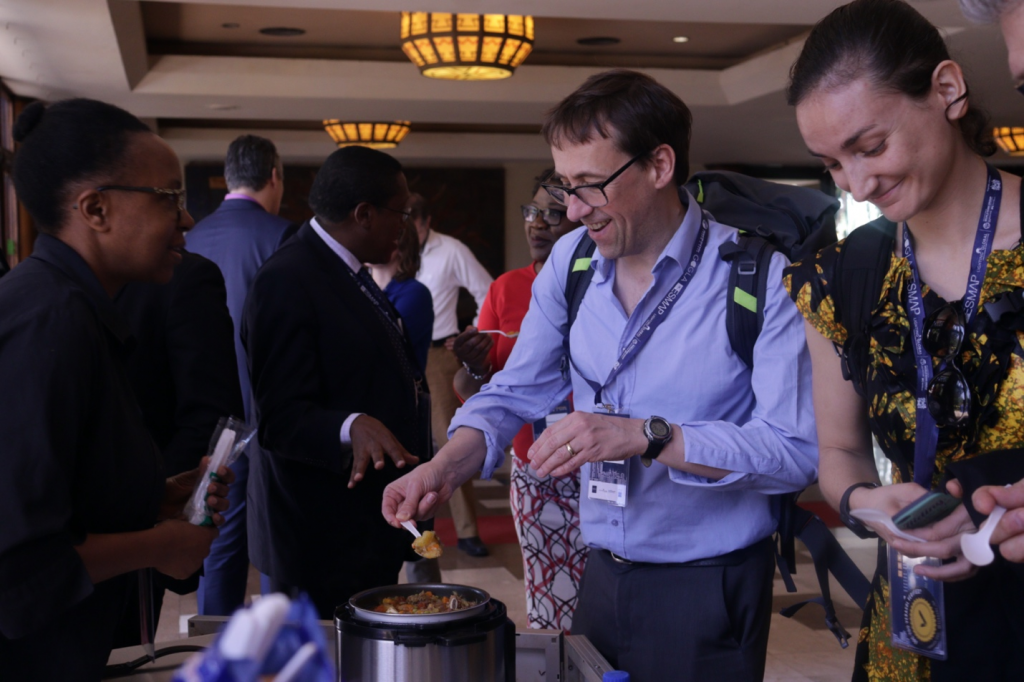
We asked our cooking diary participants how tasty each dish they prepared was compared to the fuels they usually cooked with. Perhaps surprisingly to some though, food cooked on electricity was rated as the tastiest by our cooking diary participants, just ahead of LPG & charcoal. Wood & kerosene lagged far behind. Whist most respondents missed the smokey flavour in specific foods, many did not miss it at all.
Do foods taste different when cooked on different fuels? If so, please rank each fuel for each food.
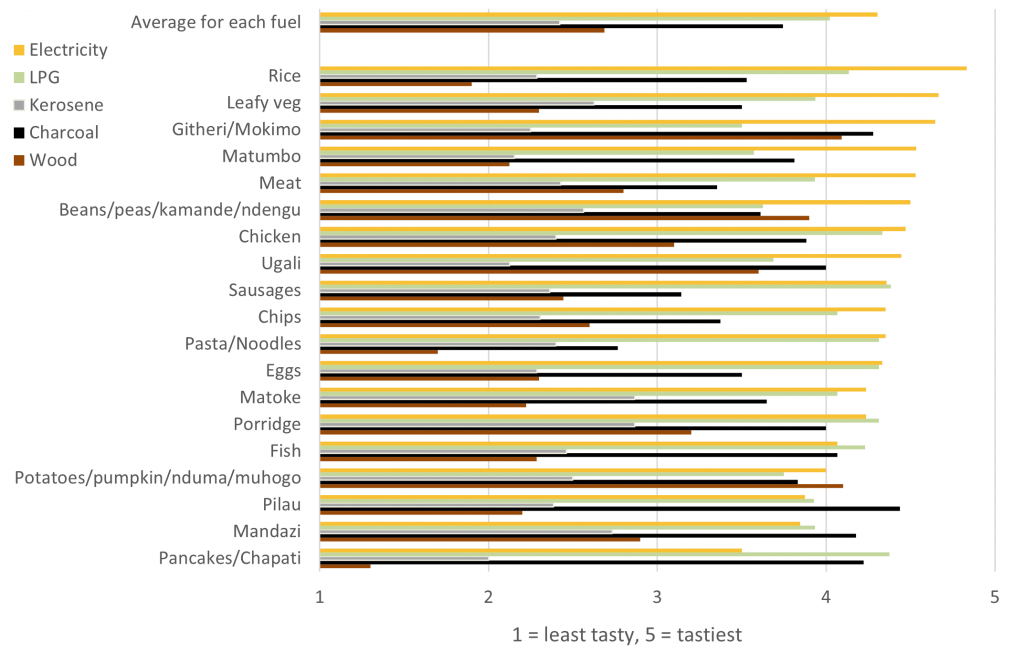
Do you miss the smokey flavour of food? If so, for which dishes in particular?

5. Where can I get these electric pressure cookers?
Whilst it used to be very difficult to acquire EPCs in Kenya, there are now several models available in a range of outlets. If you want to see the EPC before you buy, you can visit supermarkets such as Carrefour or Hotpoint’s Von-branded EPC can also be obtained directly from their showrooms. Kenya Power’s Pika na Power programme also run free cooking classes every Tuesday and Thursday at their fully fitted electric kitchen at Electricity House and you can buy the appliances on show afterwards. If you’re into virtual shopping, Jumia, the popular online platform now stocks several models of EPCs, or you can buy directly from social media guru and EPC expert, Jikoni Magic, by messaging her on Instagram or other social media platforms.
Four of most popular models on sale in Kenya at the moment are:
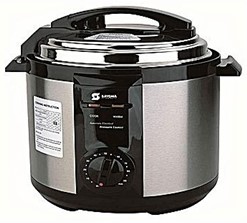
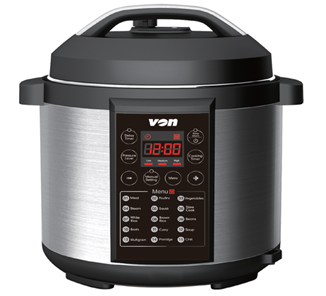
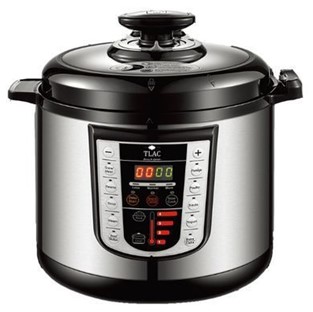
Burn Manufacturing, makers of the popular Jikokoa, have designed an EPC designed specifically for Kenyan cooks, the Ecoa. It’s a sizeable 8 litres capacity and even has a ‘githeri’ button!
………………………………….
Featured image: Agnes Kalyonge from Jikoni Magic serving githeri (bean and maize stew) cooked in an EPC to curious chefs (image credit: Monica Kalyonge, Jikoni Magic).